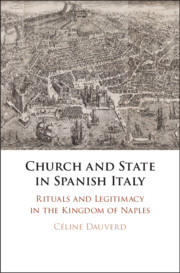Book contents
- Church and State in Spanish Italy
- Church and State in Spanish Italy
- Copyright page
- Contents
- Figures
- Table
- Acknowledgments
- Introduction
- 1 The Spaniards in Charitable Institutions
- 2 Viceroys, Jews, and Conversos
- 3 The Miracle of San Gennaro
- 4 Easter Processions
- 5 Corpus Domini Celebration
- 6 San Giovanni a Mare
- Conclusion
- Bibliography
- Index
2 - Viceroys, Jews, and Conversos
Published online by Cambridge University Press: 09 March 2020
- Church and State in Spanish Italy
- Church and State in Spanish Italy
- Copyright page
- Contents
- Figures
- Table
- Acknowledgments
- Introduction
- 1 The Spaniards in Charitable Institutions
- 2 Viceroys, Jews, and Conversos
- 3 The Miracle of San Gennaro
- 4 Easter Processions
- 5 Corpus Domini Celebration
- 6 San Giovanni a Mare
- Conclusion
- Bibliography
- Index
Summary
“In the summer of 1492, the first wave of Jewish refugees reached Naples from Spain and Sicily.”1 King Ferrante of Naples, King Ferdinand’s brother-in-law, initially welcomed the Jews. In 1510, however, when Naples had fallen under direct control of Spain and was ruled by Spanish viceroys, King Ferdinand proposed to establish the Spanish Inquisition in order to deal properly with religious heterodoxy. From the time of the expulsion in 1492, the Spanish monarchs sought to maintain a respublica christiana throughout their domains because political stability was thought to rest on the unity of creed between ruler and subjects. Unorthodox beliefs, seen as heresy, were perceived to be destructive to the common good. Like Spain, Kenneth Stow argues, Italy exhibited a static introspection prompted by a residual medieval attitude seeing the Jews as contaminating Christian communities.2 So when, upon the expelled Jews’ arrival in southern Italy, the lack of sanitary conditions triggered an epidemic of plague, the Jews became associated with medical as well as spiritual pestilence.3 According to Stow, driven by an ecclesiastical ethos of discipline, Italy sought to resolve its Jewish problem through a scheme of overall control: isolation, demarcation, and usurpation.4
- Type
- Chapter
- Information
- Church and State in Spanish ItalyRituals and Legitimacy in the Kingdom of Naples, pp. 64 - 102Publisher: Cambridge University PressPrint publication year: 2020

